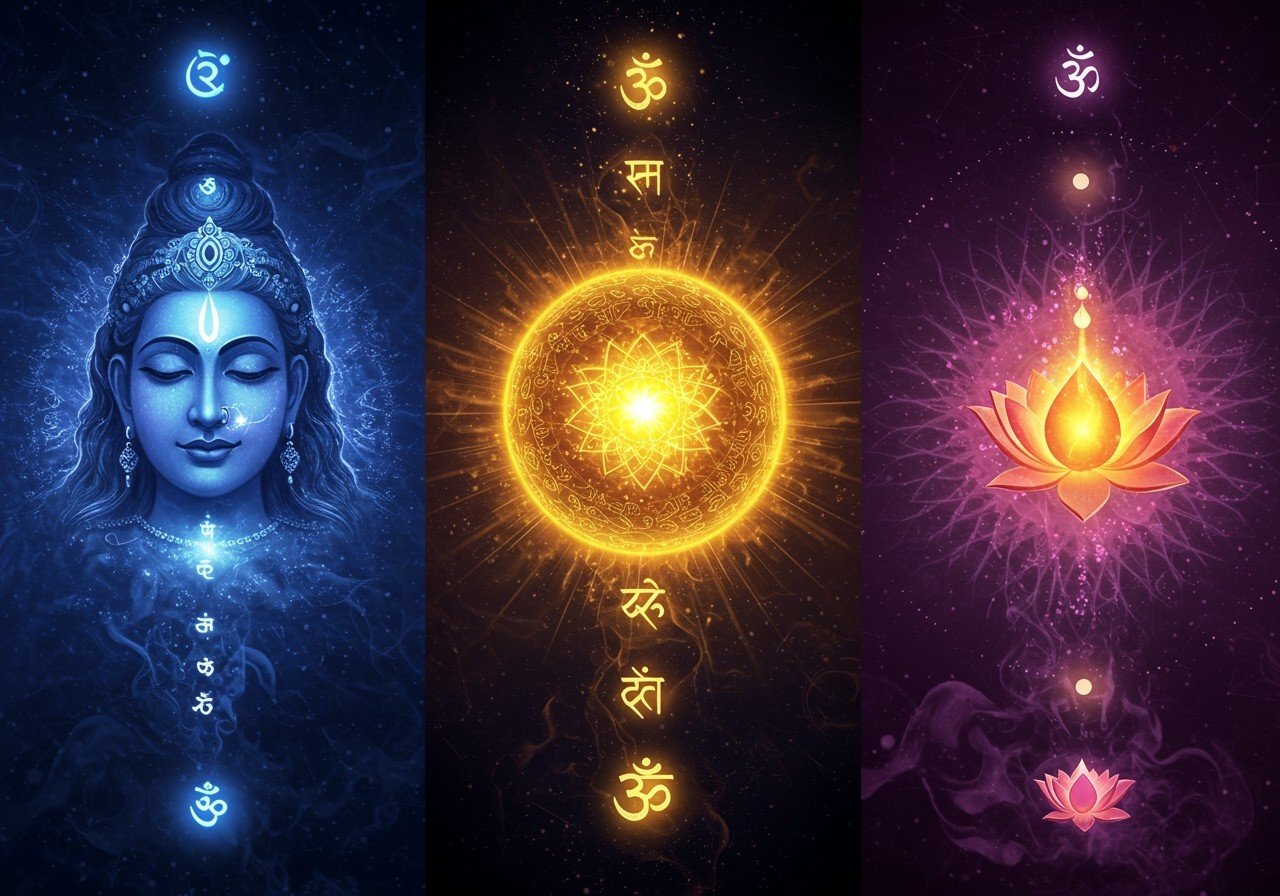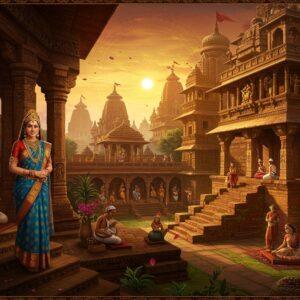
Understanding the profound concepts of Paramatman, Atman, and Brahman is essential to grasp Hindu philosophy. These terms reflect the essence of self and universe, forming a pathway to spiritual insight. They are interrelated yet distinct, shaping spiritual discussions and practices. Appreciating their importance enriches Hindu beliefs and rituals. For those seeking a deeper understanding, Poojn.in offers a curated selection of sacred texts and spiritual resources. Explore Poojn.in’s collection to enhance your spiritual journey.
Understanding Atman
Atman is the inner self or soul, the true essence of an individual, beyond physical and mental states. It’s seen as eternal and unchanging, eventually merging with the universal spirit. Hindu texts, such as the Upanishads, describe Atman as the core of every being, crucial for self-realization and liberation (moksha). Atman plays a key role in meditation and other spiritual practices aimed at self-discovery. Deepening your understanding of Atman can be facilitated with resources like meditation cushions and prayer beads available at Poojn.in.
Exploring Paramatman
Paramatman signifies the Supreme Self, a universal spirit beyond individual existence. Often equated with God, it represents ultimate reality in Hinduism. The relationship between Atman and Paramatman portrays individual souls as reflections of this Supreme Self. Sacred texts like the Bhagavad Gita depict Paramatman as a divine overseer and guide, helping individuals reach their spiritual goals. Delve deeper into the Bhagavad Gita and other sacred texts to understand Paramatman’s significance.
Brahman: The Ultimate Reality
Brahman is the ultimate, unchanging reality, surpassing the physical world and human understanding. As the source of all existence, it’s described as infinite and eternal. While related to Paramatman, Brahman’s concept differs in Hindu cosmology. Vedanta philosophy emphasizes the unity of Atman and Brahman as the path to liberation. Understanding Brahman helps comprehend reality and the cosmos. Explore Hindu scriptures to grasp the concept of Brahman further.
Paramatman vs. Atman: The Individual and the Universal
Analyzing the distinctions between Paramatman and Atman reveals their roles in spiritual growth. Realizing their unity is key to enlightenment and liberation. Hindu philosophers’ teachings highlight the link between individual souls (Atman) and the Supreme Self (Paramatman). This relationship is vital in personal and communal spiritual practices. Brass Om symbols and copper puja items can enhance your connection with these concepts. Find these and other spiritual tools at Poojn.in.
Paramatman vs. Brahman: Different Aspects of the Divine
Examining Paramatman and Brahman shows their unique roles in Hindu theology. Paramatman acts as a personal deity or guide, while Brahman represents the impersonal absolute reality. Philosophical debates explore these concepts’ implications for understanding divinity. Together, they provide a comprehensive view of the divine. Poojn.in offers resources to help you navigate these complex theological concepts.
Jivatman and Its Connection to Paramatman
Jivatman, the embodied soul, strives for union with Paramatman through spiritual practices. This concept helps us understand the cycle of birth and death within the broader framework of Hindu philosophy.
Understanding Atman
The concept of Atman is central to Hindu philosophy. Atman is the inner self, the true Self, or soul. It’s not merely a component of identity but the eternal, unchanging essence of a being, unlike the ever-changing body and mind. Atman transcends temporary labels like race, gender, or nationality. Enhance your understanding of Atman with Poojn.in’s insightful guide.
Atman and Brahman
Many Hindus believe Atman and Brahman are one. Brahman is the ultimate reality underlying all existence. This emphasizes the interconnectedness of the soul and the divine. Realizing this unity is the highest goal, recognizing our true, pure, and divine nature.
The Eternity of Atman
Atman is eternal, existing beyond time. The innermost self, shining brightly, unaffected by ego or personality. This timelessness guarantees its imperishability, comforting spiritual seekers. Explore India’s spiritual heart at Poojn.in.
Self-realization Through Spiritual Discipline
All yoga and spiritual practices aim to unveil the true self. The Bhagavad-Gita suggests this is achievable through study, meditation, and selfless acts. Shifting focus from external to internal happiness is crucial. Find resources for your spiritual journey at Poojn.in.
Consciousness and Atman
Consciousness reveals Atman’s presence. Without a soul, the body lacks awareness, making Atman essential for our being. Enhance your awareness with Poojn.in’s collection of bhajans and kirtans.
Distinction Between Atman and Jivatman
Atman differs from Jivatman, the individual soul bound by karma and rebirth. Jivatman carries past impressions across lifetimes. Some philosophies distinguish Atman from the material ego and emotional mind, focusing on its eternal aspect.
Liberation: The Path to Moksha
Moksha, or liberation, requires self-knowledge, understanding one’s true self as part of the divine. It’s a journey of embracing our eternal Atman and transcending worldly attachments. Explore ancient culture with Poojn.in.
Understanding these concepts enriches Hindu beliefs and practices, guiding those seeking spiritual understanding and liberation. Poojn.in offers a wide variety of products to support your spiritual journey, from incense and prayer beads to statues and sacred texts. Visit Poojn.in today to discover more.
How Poojn.in Supports Your Spiritual Journey
Poojn.in connects you with Paramatman, Atman, and Brahman concepts through authentic puja items and spiritual resources:
- Pure brass and copper items for Brahman meditation rituals. These items are crafted according to traditional methods to enhance your spiritual practice.
- Traditional japa malas (prayer beads) for Atman contemplation. Each bead is carefully selected and strung to aid in your meditative focus.
- Sacred texts and scriptures explaining these concepts. Our collection includes authentic versions with commentary to deepen your understanding.
- Puja thalis and accessories for daily worship. We offer a wide range of sizes and styles to suit your individual needs.
- Genuine sandalwood products for meditation. Our sandalwood is ethically sourced and of the highest quality, promoting a calming atmosphere.
- Pure cotton prayer shawls and meditation cushions. These provide comfort and support during your spiritual practice, enhancing your focus and connection.
Visit www.poojn.in for our complete collection. Authenticity and religious compliance verified by Hindu priests and scholars. Secure India-wide delivery protects sacred items.
Embracing the Divine Trinity
Exploring Atman, Brahman, and Paramatman reveals Hindu philosophy’s depth. Atman (individual soul) connects us to Brahman (ultimate reality) and Paramatman (supreme self). This trinity guides us toward self-realization and enlightenment, nurturing a deeper connection to our eternal essence and the universe. This wisdom brings peace, honoring tradition while navigating our spiritual journey with grace.
FAQs: Paramatman vs. Atman vs. Brahman
What is the difference between Atman and Paramatman? Atman is the individual soul in every being; Paramatman, the supreme soul in all beings and the universe. Atman is personal; Paramatman, universal. This distinction helps clarify their respective roles in spiritual development.
How does Brahman relate to Atman and Paramatman? Brahman is the ultimate reality, the cosmic spirit. Atman is the inner self; Paramatman, the supreme self. Both are aspects of Brahman, showing individual and universal connections. Understanding these relationships helps clarify the interconnected nature of reality.
Can Atman and Paramatman be the same? Essentially, yes, as both originate from Brahman. However, Atman is the individual expression of the divine, whereas Paramatman is the universal divine consciousness. They are different perspectives of the same underlying reality.
What role does Jivatman play in this divine trinity? Jivatman is the embodied soul, the living aspect of Atman in a physical form, subject to karma and reincarnation, unlike the eternal, unchanging Paramatman. This concept helps us to understand the journey of the individual soul through lifetimes.
Why is understanding Brahman important in this context? Understanding Brahman illuminates the unity of Atman and Paramatman. It connects individual consciousness and the universal spirit, giving profound spiritual insight. It helps frame the larger cosmological context within which the individual soul exists.
How do Paramatman and Brahman differ? Paramatman, the supreme soul in all beings, links individuals to the universe; Brahman is the all-encompassing ultimate reality. Paramatman is a manifestation of Brahman, serving as a bridge to the ultimate.
Is the concept of Atman unique to Hindu philosophy? Yes, Atman is central to Hindu philosophy. Similar ideas exist in other traditions (e.g., the soul in Christianity, the self in Buddhism) but with different interpretations and meanings. The specific understanding of Atman is distinct to Hindu thought.


